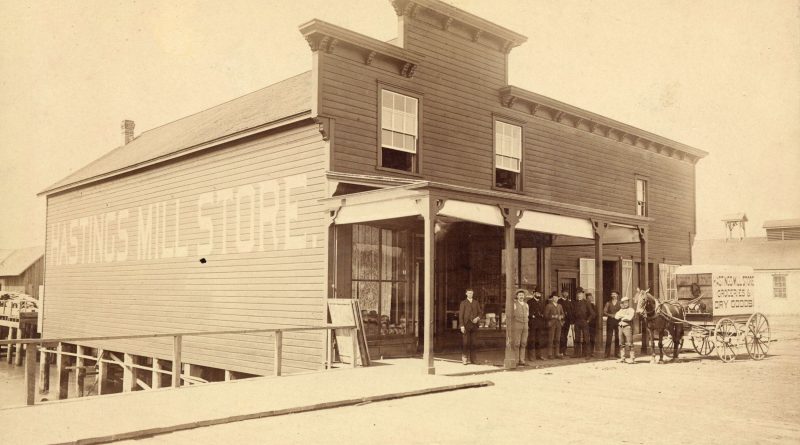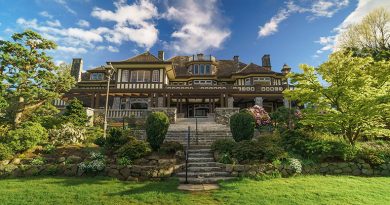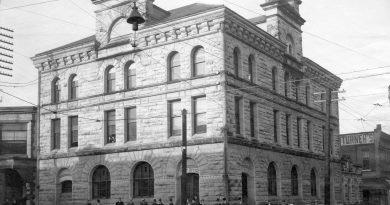1919
Above: Hastings Mill Store circa 1888
[Image: City of Vancouver Archives AM54-S4-: Mi P14 ]
*****************************************
You’ll note that these years include events listed under “Also in . . .” These are events for which we don’t have a specific date. If YOU know the specific date of an event shown there, please notify us . . . and cite the source! Many thanks!
*****************************************
January 30 The Native Daughters of B.C. was formed in Vancouver. The group’s objective was to pay tribute to the pioneers and history of the province. Today, they operate the Hastings Mill Store Museum at the north foot of Alma Street.
March 3 U.S. pilot Eddie Hubbard flew into Vancouver (landing his float plane at the Royal Vancouver Yacht Club) with the first sack of airmail from Seattle. He had a passenger: William Boeing. It had taken them two days to get here. This was the world’s first international airmail delivery.
June 1 Leonard Klinck became president of UBC. He would serve to 1944.
June 3 A general strike began in Vancouver. At its height more than10,000 workers were on strike, including some civic employees. In North Vancouver shipyards closed and streetcars halted.
July 19 A great Peace Celebration and Parade were held in Vancouver, including a Thanksgiving service in Stanley Park, led by Premier Pattullo and Vancouver’s Mayor Gale.
Early August Capt. Ernest C. Hoy, DFC, of Vancouver took off from Minoru Park on Lulu Island and flew to Calgary. Said in one sentence, it sounds unimpressive. These days a trip like that takes about an hour and a quarter. For Captain Hoy it took 16 hours and 42 minutes. His flight was the first ever made across the Canadian Rockies. This was also the first airmail delivery across the Rockies—from Richmond to Golden, Calgary and Lethbridge.
August 29 The original Lumbermen’s Arch (note the plural) was moved to Stanley Park from its original location at Pender and Hamilton—where it had been erected for the 1912 visit of the Duke and Duchess of Connaught. It was dedicated today in the park to its designer, Captain G.P. Bowie, who was killed at Ypres on July 7, 1915. Eventually it began to deteriorate and was demolished December 3, 1947, to be replaced by the present, much simpler version.
Also August 29 Twenty-five-year-old prisoner Alex Ignace was the first person hanged at Oakalla.
Summer The shady Henry Green, who never answered personal questions and refused to have his photograph taken, convinced social leader Mary Isabella Rogers to help underwrite his subscription orchestra. That was the origin of the Vancouver Symphony Orchestra. (Green is called “shady” because in later years he will skip town with orchestra money.)
September 22 Edward, Prince of Wales, 25, visited Vancouver. There was a civic reception and a military ball in the Arena in the evening with tickets at $5. He visited other areas of Greater Vancouver and opened the New Westminster Exhibition. Prior to the ball he attended a dinner as a guest of the Vancouver Club. Members went to great lengths, e.g., painting the ladies’ lavatory, providing an electrical display of the Prince’s motto Ich Dien, arranging for HRH’s favorite flowers (sweet peas), and engaging the services of Mr. Copley’s orchestra, tucked away in the dining room’s bay window. (The Prince later went on to become King Edward VIII, but abdicated in 1936.)
September The new Rotary Clinic for Chest Diseases was officially opened to provide free medical care for children. This was an outpatient clinic for the treatment and prevention of tuberculosis, the dreaded “white death” so prevalent early in the century.
November 1 The first train arrived at 7:00 p.m. at the brand-new Canadian National Railway station facing Main Street in Vancouver. First to leave (also today) was the Transcontinental Express, headed for Toronto. Today the building is called Pacific Central Station, and it’s on Station Street.
November 19 The newspapers today published a five-page section showing lots for auction by the City of Vancouver, lots seized for non-payment of taxes. Some of the lots were seized for overdue taxes totalling less than $10. There were more than TWO THOUSAND pieces of property on the list.
November 20 The death by suicide in Vancouver of former newspaper publisher, MLA, cabinet minister and first University of B.C. chancellor Francis L. Carter-Cotton, 75. He walked into English Bay and drowned himself. He had suffered two serious strokes in 1919, one just weeks before his death.
Also in 1919
Kathryn Gretzinger’s documentary A Level Playing Field, which won the 1999 Best Network Radio Feature category at the Radio and Television News Directors Association awards, and the Jack Webster Award for Best Radio feature, told the story of a group of Chinese soccer players. They formed a team in 1919, went on to play in the “mainstream” league and ended up winning some major tournaments. This was the Chinese boys’ first chance to compete on a level playing field. Before the team they were treated as outsiders, second-class citizens in Vancouver.
The Vancouver Real Estate Board, which had suspended operations during World War I, resumed its activities and has been operating ever since.
A new Town Hall was built in the Brighouse area of Richmond, replacing one that had burned to the ground in 1912.
Japanese employment in the fishing industry in the Lower Fraser reached its highest level, with 3,267 licences, about half of those issued.
A commercial fishing licence for the Fraser River cost $5.
Eggs at the Farmers’ Market in New Westminster cost $1 a dozen. Times were good for Surrey farmers, as prices forced up by the war had not yet fallen.
Arthur Mars became mayor of Port Coquitlam. His brother James had held the office earlier.
Shaughnessy Hospital opened on Oak Street.
Blythe Rogers, the eldest son of B.C. Sugar Company founder B.T. Rogers, built the stylish Tudor home originally called “Knole” at the northwest corner of 57th and Marine, shortly before his death at the age of 26.
David William Poppy, who had been reeve of Langley Municipality from 1908-13, became reeve again.
The Jones Tent and Awning building went up at 2034 West 11th Avenue. It will become a heritage building.
Thomas Adams established the Town Planning Institute of Canada.
Henry Angus became a member of the UBC faculty. The Henry Angus Building (Faculty of Commerce and Business Administration) was named for him.
The Kiwanis Club of Vancouver was established. In the Lower Mainland today there are 17 branches with more than 10,000 members.
The annual publication Scarlet & Gold began, produced by and for veterans of Royal Canadian Mounted Police, Vancouver Division).
Work on filling in False Creek east of Main Street was completed.
Ivor W. Neil, who had been operating a sightseeing bus and taxi service in Vancouver since 1915, took over Goodman Hamre’s White Rock bus service.
Cooper & Smith Towing began operations on the Fraser River. In 1932 it will become Westminster Tug Boats Inc.
Abstract painter and teacher Gordon Smith was born.
Columnist and playwright Eric Nicol was born in Kingston, Ontario. He will come to Vancouver with his family as a child.
The building of the Peace Arch began with land clearing. It will open in 1921.


![C.P.R. station [601 West Cordova Street, later a public transit terminal]](https://vancouverhistory.ca/wp-content/uploads/2020/12/18be108e-302a-4a98-9a9d-271c574a391d-A01951-390x205.jpg)

